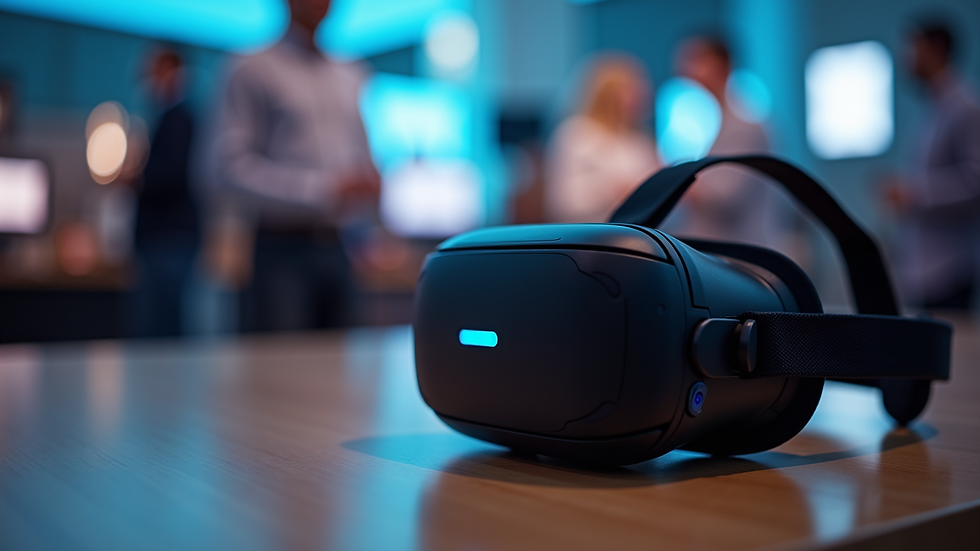Harnessing Virtual Reality Experiences for Events
- jesse barratt
- Aug 18
- 4 min read
In today’s fast-evolving digital landscape, businesses and industry leaders in Australia and New Zealand are increasingly turning to innovative technologies to captivate audiences and enhance operational efficiency. Among these technologies, virtual reality (VR) stands out as a powerful tool to transform events into immersive, memorable experiences. By integrating virtual reality event solutions, companies can elevate training programs, customer engagement, and brand storytelling in ways that traditional methods cannot match.
Exploring Virtual Reality Event Solutions for Business Impact
Virtual reality event solutions offer a unique blend of immersion and interactivity that can revolutionise how businesses connect with their audiences. These solutions are not just about entertainment; they provide practical applications that drive measurable outcomes.
For example, in corporate training, VR can simulate real-world scenarios that allow employees to practice skills safely and effectively. This is particularly valuable in industries such as healthcare, manufacturing, and logistics, where hands-on experience is critical but often costly or risky to replicate in real life.
In customer engagement, VR enables brands to create interactive product demonstrations or virtual showrooms. This approach allows potential clients to explore products or services in a controlled, engaging environment, increasing the likelihood of conversion and customer satisfaction.
Some key benefits of virtual reality event solutions include:
Enhanced engagement through immersive storytelling and interactive elements.
Improved knowledge retention by providing experiential learning opportunities.
Cost savings by reducing the need for physical materials and travel.
Scalability to reach wider audiences without geographical constraints.

How to Integrate Virtual Reality Experiences into Your Events
Successfully incorporating virtual reality experiences into events requires thoughtful planning and execution. Here are practical steps to ensure your VR initiatives deliver maximum impact:
Define clear objectives - Identify what you want to achieve with VR, whether it’s training, marketing, or customer engagement.
Choose the right VR content - Select or develop content that aligns with your goals and resonates with your audience.
Invest in quality hardware - Use reliable VR headsets and peripherals to ensure a smooth and comfortable user experience.
Train facilitators - Equip your event staff with the knowledge to assist participants and troubleshoot technical issues.
Create a seamless flow - Integrate VR sessions naturally within the event agenda to maintain engagement without overwhelming attendees.
Gather feedback - Use surveys or analytics to measure the effectiveness of the VR experience and identify areas for improvement.
For instance, a Melbourne-based logistics company used VR simulations during their annual conference to train staff on warehouse safety protocols. The immersive training reduced accidents by 30% within six months, demonstrating the tangible benefits of VR integration.
What's the Best Virtual Reality to Get?
Choosing the best virtual reality system depends on your specific event needs, budget, and technical capabilities. Here are some popular options to consider:
Oculus Quest 2: A standalone headset known for its ease of use and affordability. Ideal for events requiring mobility and quick setup.
HTC Vive Pro: Offers high-resolution visuals and precise tracking, suitable for detailed simulations and professional applications.
Valve Index: Known for its superior audio and visual fidelity, perfect for premium immersive experiences.
PlayStation VR: A cost-effective option for entertainment-focused events, especially if you already have PlayStation consoles.
When selecting a VR system, consider factors such as:
Compatibility with your VR content.
User comfort for extended sessions.
Technical support availability.
Scalability for multiple users or simultaneous sessions.
Investing in the right hardware ensures your virtual reality event solutions run smoothly and leave a lasting impression.

Practical Examples of Virtual Reality in Events Across Industries
Virtual reality is making waves across various sectors by enhancing event experiences in innovative ways:
Healthcare: Medical conferences use VR to simulate surgeries or patient interactions, providing hands-on learning without risk.
Real Estate: Property developers showcase virtual tours of unbuilt homes, allowing buyers to explore layouts and finishes before construction.
Retail: Brands create virtual stores where customers can browse and interact with products from anywhere.
Education: Universities host virtual open days, enabling prospective students to explore campuses remotely.
Manufacturing: Companies demonstrate complex machinery operation through VR, reducing the need for physical prototypes.
These examples highlight how VR can be tailored to meet diverse business objectives, making events more engaging and effective.

Maximising ROI with Virtual Reality Event Solutions
To ensure your investment in virtual reality event solutions delivers strong returns, consider these actionable recommendations:
Align VR content with business goals to ensure relevance and impact.
Leverage data analytics from VR sessions to gain insights into participant behaviour and preferences.
Promote VR experiences before and after events through social media and email campaigns to maximise reach.
Combine VR with other technologies such as augmented reality (AR) and artificial intelligence (AI) for richer experiences.
Plan for scalability to accommodate growing audiences or multiple event locations.
By following these strategies, businesses can harness the full potential of VR to boost engagement, improve training outcomes, and enhance brand perception.
Virtual reality is no longer a futuristic concept but a practical tool that can transform events into dynamic, immersive experiences. By adopting virtual reality event solutions, businesses in Australia and New Zealand can stay ahead of the curve, delivering innovative experiences that resonate deeply with their audiences and drive meaningful results. For more insights on how to implement these cutting-edge technologies, explore virtual reality experiences and discover tailored solutions that fit your unique needs.




